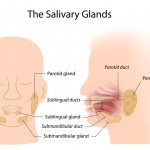
Obstructive salivary gland disease results from a blockage as a result of calculi (sialolithiasis), stenosis or anatomic variations in the ductal system, intraductal fibromucinous plugs or foreign bodies. Between 31-73% of cases are caused by calculi. Diagnosis and management was revolutionised by the introduction of sialendoscopy the 1990s which offers a minimally invasive approach.
The aim of this review was to assess the efficacy and safety of sialendoscopy in the treatment of obstructive diseases of the major salivary glands in all patients.
Methods
A review protocol was registered in the PROSPERO database. Searches were conducted in the Medline/PubMed, Embase, Cochrane Library and OpenGrey databases. Randomised clinical trials (RCTs), non-randomised clinical trials (nRCTs), cohort studies, case–control studies and case series reporting on success rates of sialendoscopy with a minimum of five cases were considered. Two reviewers independently screened the papers. A single reviewer extracted data with a second reviewer checking a random sample of 30% of the data. Risk of bias was assessed independently by two reviewers using the Cochrane risk-of-bias (RoB2) tool for RCTs the Newcastle- Ottawa Scale (NOS) for cohort and case–control studies and the Institute of Health Economics quality appraisal checklist for assessing case series. The primary outcome assessed was the success rate. Secondary outcomes included the use of supportive devices, number of sialadenectomies and complications.
Results
- 91 studies involving 8218 patients undergoing 9043 sialendoscopic procedures were
- 71 studies were of a cohort design, 2 case-controlled, and 18 case series. 80 were of a retrospective design and 11 prospective.
- A majority of studies were considered to be at medium to high risk of bias.
- 4461 procedures were on the submandibular gland, 4035 on the parotid gland and 15 on the sub-lingual gland with no gland specified for 532 procedures.
- Patients ages ranged from 1 to 99 years.
- 43 studies were limited to paediatric patients.
- Mean follow-up time was 20.3 months (range 7 days to 262 months).
- Meta-analysis showed an overall pool success rate of 80.9% with a number of subgroup analyses showing success rates varying from 45.8% to 89.6% (see table below).
| No. of Studies | Success rate (95%CI) | |
| Overall | 83 | 80.9% (76.6 to 84.6 %) |
| Patients with sialolith | 48 | 89.6% (85.7 to 92.5 %) |
| Patients with stenosis | 14 | 56.3% (48.7 to 63.6 %) |
| Submandibular glands | 25 | 88.3% (82.4 to 92.4 %) |
| Parotid glands | 36 | 81.2% (73.4 to 87.1 %) |
| Patients treated by an endoscopic-assisted transoral removal of a sialolith | 8 | 86.3% (77.4 to 92.0 %) |
| Patients treated by a combined approach of the parotid gland | 14 | 78.2% (66.7 to 86.5 %) |
| Patients with juvenile recurrent parotitis (JRP) | 12 | 67.0% (53.1 to 78.4 %) |
| Patients with radioiodine induced sialadentitis (RAIS) | 6 | 45.8% (26.9 to 66.0 %) |
Conclusions
The authors concluded: –
The success rate of sialendoscopy did not considerably change in the last 9 years. Sialendoscopy is an efficient and safe procedure for the treatment of major salivary gland obstructive disease.
Comments
A protocol for this review was published on the PROSPERO database and a good range of databases searched. The review found a high success rate of 80.9% for sialendoscopy with the results being similar to findings of earlier reviews (Dental Elf – 29th Oct 2012, Dental Elf – 29th Jun 2015). While a large number of studies were included in this review, they were all observational in nature with a majority (80 out of 91) were retrospective in nature and more prone to bias. The authors also indicate that most of the included studies were considered to be at medium to high risk of bias. Consequently, the findings of this review should be viewed cautiously. Interestingly another recent publication by Kallas-Silva et al 2023., reviewed 13 reviews of sialendoscopy concluding,
Most studies demonstrated high efficacy and safety of sialendoscopy, but with critically low quality of evidence. We still lack randomized studies in this field, and future systematic reviews on the topic should follow current guidelines to improve conduction and reporting.
Links
Primary Paper
Beumer LJ, Vissink A, Gareb B, Spijkervet FKL, Delli K, van der Meij EH. Success rate of sialendoscopy. A systematic review and meta-analysis. Oral Dis. 2023 Jul 24. doi: 10.1111/odi.14662. Epub ahead of print. PMID: 37486613.
Other references
Kallas-Silva L, Azevedo MFD, de Matos FCM, Petrarrolha SP, Dedivitis RA, Kulcsar MAV, Matos LL. Sialendoscopy for treatment of major salivary glands diseases: a comprehensive analysis of published systematic reviews and meta-analyses. Braz J Otorhinolaryngol. 2023 Jul 15;89(5):101293. doi: 10.1016/j.bjorl.2023.101293. Epub ahead of print. PMID: 37487402; PMCID: PMC10382863.
Dental Elf – 29th Jun 2015
Dental Elf – 29th Oct 2012
Review finds good success rates with sialendoscopy for treating salivary gland obstruction
